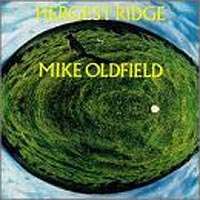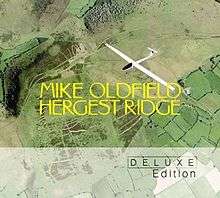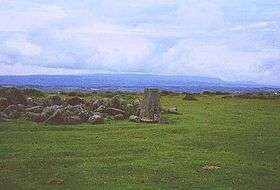Hergest Ridge (album)
| Hergest Ridge | ||||
|---|---|---|---|---|
 | ||||
| Studio album by Mike Oldfield | ||||
| Released | 28 August 1974 | |||
| Recorded | The Manor, spring 1974 | |||
| Genre | Progressive rock | |||
| Length | 40:14 | |||
| Label |
Virgin Mercury (2010 reissue) | |||
| Producer |
Tom Newman Mike Oldfield | |||
| Mike Oldfield chronology | ||||
| ||||
| Mercury Records 2010 reissue | ||||
 The revised aerial photograph artwork. The Deluxe Edition is shown. |
||||
| Professional ratings | |
|---|---|
| Review scores | |
| Source | Rating |
| Allmusic | |
| Džuboks | (Mixed)[2] |
Hergest Ridge is the second record album by Mike Oldfield, released in 1974 on Virgin Records. The album was reissued with bonus material and new artwork in June 2010.[3]
During 1973, Oldfield was uncomfortable with the public attention that he had received from the success of Tubular Bells, and retreated to the English countryside to work on his follow-up. The result was Hergest Ridge, named for the hill near Kington, Herefordshire on the border between England and Wales, and near where he was living at the time.
Hergest Ridge entered the UK album charts at number one, only to be displaced by its predecessor, Tubular Bells. Oldfield is thus one of only a few artists (among whom are The Beatles and Bob Dylan) to have defeated themselves in this manner.
Album analysis
Similarly to Tubular Bells, the album is divided into two movements, although Hergest Ridge makes more economical use of its various themes and has more sophisticated musical development than its multi-themed and rapidly changing predecessor. Oldfield is innovative on Hergest Ridge in the novel way in which he builds up complex textures; he frequently superimposes multiple layers of electric guitar recorded by first amplifying heavily (to achieve a sustained organ-like quality) and then reducing the volume greatly via use of the Glorfindel Box and the compression channel from the Manor Mixing Console, as he did on the "Guitars Sounding Like Bagpipes" section from Tubular Bells Part 2. Textures are extended further using various organ timbres and the use of voice as an instrument (the voice is never treated prominently and is deliberately reduced as much as possible and thus permitted largely for textural effect).
According to producer Tom Newman, parts of the album were also recorded at Chipping Norton, and the original release mix created at Air Studios, London.
The album is mentioned by name: "I ain't got no time for intellectual music, e.g. Hergest Ridge", in the Alberto y Lost Trios Paranoias 1978 single "Heads Down No Nonsense Mindless Boogie".
Versions
Hergest Ridge was remixed in SQ system 4-channel quadraphonic sound by Oldfield in 1976 for the 4-LP set, Boxed. Following the creation of the remix, Oldfield stated that he wished for all future releases of the album to be derived from this new version. All CD releases have a stereo mix derived from the "Boxed" mix, as do most of the later pressings of LP and cassette. The original 1974 vinyl mix is now available on the 2010 reissue of the album, along with a 2010 remix.
In 1976 an orchestral version of Hergest Ridge was arranged and conducted by David Bedford, who had previously undertaken the same tasks on The Orchestral Tubular Bells. Parts of its performances were used in the NASA and Tony Palmer documentary The Space Movie. As of 2014 it has not been officially released.
Hergest Ridge, the place

Hergest Ridge on the England–Wales border is a popular holiday destination for Oldfield's fans, and the house where he lived at the time, The Beacon, is now a guest house. The cover photograph features scenery from Hergest Ridge, and was taken by Trevor Key; the Irish Wolfhound on the cover (and on the LP label) was named Bootleg. Mike Oldfield himself can indeed be heard pronouncing it in the song "On Horseback", which concludes "Part Two" of Ommadawn.
Although the album was written at The Beacon, it was again recorded at Richard Branson's The Manor, like Tubular Bells.
Track listing
All music composed by Mike Oldfield.
Side one
- "Hergest Ridge (Part One)" – 21:29
Side two
- "Hergest Ridge (Part Two)" – 18:45
Personnel
- Mike Oldfield – acoustic guitar, bass guitar, electric guitars; Farfisa, Gemini, and Lowrey organs; glockenspiel, gong, mandolin, nutcracker, sleigh bells, Spanish guitar, timpani, and tubular bells
- Chilli Charles – snare drum
- Lindsay Cooper – oboe
- Ted Hobart – trumpet
- William Murray – cymbal
- Sally Oldfield – vocals
- Terry Oldfield – woodwinds
- Clodagh Simonds – vocals
- June Whiting – oboe
- London Sinfonietta Voices – choir (according to David Bedford)
- String players, conducted by David Bedford
Mercury Records reissue
On 7 June 2010 the album was re-released by Mercury Records. This came as part of a deal in which Oldfield's Virgin albums were transferred to Universal's label. Bonus features for the release include a 2010 remix of the album and the original vinyl mix of the album. There is a single disc edition[4] as well as a Deluxe Edition. Bonus tracks include "In Dulci Jubilo (For Maureen)" and "Spanish Tune".[5] A 180 gram vinyl version was released as part of the Back to Black range.[6]
The reissue features radically different artwork, which features a model glider and aerial photography based on Google Earth and Bluesky. According to the new liner notes, Oldfield was never entirely happy with the original album artwork and took this opportunity to commission a new cover.
There is also a limited edition box set of the album, comprising a deluxe edition, an LP and a framed, signed print of the album artwork. Only 250 copies were produced, which were sold through Mike Oldfield's official website.[7] There are no un-signed variants.
The Japanese release uses the SHM-CD (Super High Material CD) manufacturing process.
Single Disc Edition
Back To Black Edition Vinyl Edition
Limited EditionLimited edition available through mikeoldfieldofficial.com, which contains the deluxe edition the vinyl edition and a numbered framed print of the cover artwork, signed by Mike Oldfield. Also includes Walking The Hergest Ridge booklet. Only 250 copies were available on pre-order prior to the release on 14 June 2010. Digital Edition
|
Deluxe Edition
CD 2
DVD
|
Charts
Hergest Ridge was the UK's number one album the week of 14 September 1974 and remained so for three weeks until being knocked out of the spot by its predecessor Tubular Bells. Oldfield is thus one of only a few artists (among whom are The Beatles and Bob Dylan) to have defeated themselves in this manner.
| Chart (1974) | Position |
|---|---|
| Dutch Albums (MegaCharts)[8] | 12 |
| Spanish Albums (PROMUSICAE)[9] | 54 |
| UK Albums (OCC)[10] | 1 |
| Preceded by Band on the Run by Paul McCartney & Wings |
UK number one album 14 September 1974 – 4 October 1974 |
Succeeded by Tubular Bells by Mike Oldfield |
References
- ↑ Hergest Ridge at AllMusic
- ↑ Konjović, S. "Mike Oldfield – Hergest Ridge". Džuboks (in Serbian). Gornji Milanovac: Dečje novine (8 (second series)): 22.
- ↑ "Classic Rock presents Prog – Hergest Ridge and Ommadawn reviews", Classic Rock, May 2010
- ↑ "Hergest Ridge". Amazon.co.uk. Retrieved 28 March 2010.
- ↑ "Hergest Ridge Deluxe Edition". Amazon.co.uk. Retrieved 27 March 2010.
- ↑ "Hergest Ridge Limited 180 gram Vinyl LP". What Records. Retrieved 28 March 2010.
- ↑ "Hergest Ridge & Ommadawn – Deluxe Editions – 7th June 2010". MikeOldfieldOfficial.com. 27 April 2010. Retrieved 27 April 2010.
- ↑ "Dutchcharts.nl – Mike Oldfield – Hergest Ridge" (in Dutch). Hung Medien. Retrieved 8 April 2013.
- ↑ "Spanishcharts.com – Mike Oldfield – Hergest Ridge". Hung Medien. Retrieved 8 April 2013.
- ↑ September 1974 "Official Albums Chart Top 100". Official Charts Company. Retrieved 8 April 2013.